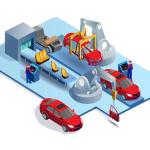Your business plan might include projections that your revenue will take you from being in the red to fully profitable within less than three years. That’s good.
There might be data that shows you could eventually expand your operations to serve customers at the other end of the world — customers who remain loyal. That’s even better.
The one thing your business plan may have left out, however, is the impact you’re going to have on the planet. In other words, how will the way you operate contribute — positively or negatively — on our collective ability to sustain our natural resources?
Small and medium-sized businesses might not have traditionally focused on sustainability as they established their business model because they felt they had more pressing goals. After all, most business plans are designed to prove to banks, venture capitalists and other investors that the company will be a viable long-term bet.
Those financial decisions are often based upon whether the business plan demonstrates a good product-market fit, a compelling sales and marketing strategy and a sense that the necessary resources will be well-managed.
When SMBs prepare to answer the tough questions, they might not be expecting to be asked how they’ll help combat climate change. Why bother talking about reducing your carbon footprint when you’ve yet to take your first real step towards creating one?
Today, however, it’s no longer possible to run a business — or even try to start one — and act as though the environment weren’t facing an urgent crisis. Back in August at the Intergovernmental Panel on Climate Change (IPCC), for instance, the data presented on climate change was characterized as a “code red for humanity.”
More recently, the United Nations’ COP26 summit in Glasgow underscored the severity of deforestation, alarming levels of methane in the atmosphere and more. It has become clear that sustainability issues affect all of us, including businesses of every size.
Whether you’re still developing your business model or in the process of delivering on it amid your path to growth, consider some of the following action items:
1. Reframe Your Goals With Net Zero In Mind
In many cases, companies focused on the bottom line without paying a lot of attention to the greenhouse gas emissions they would be generating. That means there’s a lot of catch-up going on as firms race to offset their emissions now.
SMBs may have an advantage in setting out to achieve net zero targets from the moment they launch onwards. The use of technologies like Salesforce Net Zero Cloud make it easier than ever by helping to collect, manage and analyze all the data related to their environmental impact.
2. Identify Your Green Team, And Empower Them
Many large companies have tried to tackle environmental issues by appointing a chief sustainability officer. Though the nature of the role varies, this is usually someone who acts as the primary stakeholder to manage projects, processes or policies involving sustainability.
Though in some sense we all have to start thinking like chief sustainability officers, SMBs will probably operate in “greener” ways if they have specific employees in place to monitor environmental data and to inform any changes that need to be made.
3. Create An Internal Marcom Plan To Talk About Sustainability
A traditional business model often involves developing strategies to tell stories that generate demand and create affinity for your brand. These will be a blend of marketing and communication (or marcom) strategies that could involve everything from advertising to public relations.
Consider doing something similar to ensure everyone within your company has a window into your sustainability journey. This could include goals, challenges or setback you’ve faced and hopefully success stories as you make progress towards key milestones. This content could be featured in an employee newsletter, an intranet or even a dedicated Slack chanel.
4. Connect To Your Local Community And Business Ecosystem
Business models usually depend on partnerships that will be integral to their success. You’ll also need to collaborate with others to tackle issues like climate change. No matter where you operate, there are likely non-profits and charities who could benefit from your team’s talent and resources.
If you’re truly committed to sustainability, your business model will prove it by clarifying the kinds of values that will inform who you choose as suppliers and vendors within your larger business ecosystem. Although SMBs are obviously focused on pleasing their customers, they also operate as customers in a B2B context. That means they have power and influence too.
5. Include Sustainability Metrics As You Track Business Performance
Your business plan probably makes some reference to customer acquisition costs, customer churn and Net Promoter Scores as ways you’ll evaluate your success. But what about looking to the U.N.’s Sustainable Development Goals as well?
Why not factor in sustainability benchmarks and tools like the Green Business Bureau’s Scorecard as a metric too?
Make sure you look for connections between traditional business and sustainability metrics. Establish feedback mechanisms that show your efforts to drive sustainability align with what your customers want and expect from you.
Business models usually don’t change unless a powerful new force emerges that requires us to rethink our approach to how companies should run. The rise of digital technologies was one such force, and now even the smallest firms are able to act like much larger entities through the strategic use of technology.
The climate crisis is another example. Companies that put sustainability at the heart of their business model are more likely to have an engaged workforce, customers who feel good about purchasing from them and — most importantly — a legacy they can leave behind to future generations.

























